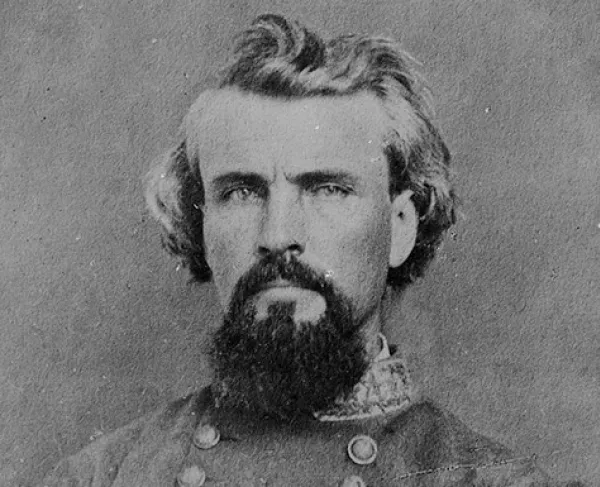
Battle of Jackson
Jackson
Old Salem Cemetery
Madison County, TN | Dec 19, 1862
The Battle of Jackson on December 19, 1862, was a Confederate attempt to delay the movements of the Union troops towards Vicksburg, Mississippi. Gen. Nathan Bedford Forrest staged a Confederate attack at Salem Cemetery to distract Federal troops from his men destroying the Union railroad that led into Corinth, Mississippi.
How It Ended
Although the Union successfully defended Jackson, the Confederates won a strategic victory. The Confederates destroyed parts of the Union railroad leading toward Corinth, Mississippi and bought time for the Confederates to prepare for a battle at Vicksburg, which eventually fell to Gen. Ulysses S. Grant on July 4, 1863.
In Context
After the Union victory at the Battle of Shiloh in April 1862, the Union gained control of Corinth, Mississippi and Nashville, Tennessee. The city of Corinth was a vital hub because it served as the crossroads of two major railroads, and gaining control of the city meant gaining access to the Confederate heartland. With this advantage, the Confederates knew that Gen. Ulysses S. Grant and his army would be moving towards Vicksburg, Mississippi next. If the Union could successfully take Vicksburg, then the South would be weakened and divided in two.
With Corinth, Mississippi under Union control and unmitigated access to the two different railroad lines in the state, it was only a matter of time before Gen. Grant moved towards Vicksburg, Mississippi. If Vicksburg, Mississippi fell, then the Confederacy would lose access to the Mississippi River and split the South in half. To quell or at least delay Union movement towards Vicksburg, Southern troops tried to retake Corinth in October 1862. However, motivated by the importance of defending the critical railroad junction, Union Gen. Rosecrans and his army defeated the Confederates in this attempt.
With no hope of regaining the Corinth junction and access to the railroads, Confederate Gen. Nathan Bedford Forrest began sabotaging parts of the railroad line, rather than trying to retake them. Gen. Grant and his army relied on supplies by way of these railroad lines that passed through Jackson, Tennessee. Forrest and his men moved towards the city of Jackson, defeating a unit of Union cavalry on their way. As the Confederates moved into Jackson, they encountered Union Col. Adolph Engelmann and his garrison.
600
400
As Gen. Nathan Bedford Forrest and his men approached the city, Col. Adolph Engelmann was instructed to merely monitor the advance and ordered his men to take up a defensive position at the Old Salem Cemetery. 400 Confederates charged toward the defenders in a column formation and the Union regiment repulsed the attacks.
While the Union was successful in repulsing the attack, Engelmann was unaware that the charge was a distraction from Forrest’s real mission. As the two sides clashed at Salem Cemetery, Forrest led some of his men north to a stretch of undefended railroad and destroyed it. Having achieved this strategic victory, Forrest withdrew from the area and turned to raid other Tennessee towns.
6
0
Although Forrest’s attack seemed minor in the grand scheme of the Western Theater, he managed to prove himself as a tactically capable commander and earned himself a reputation as an antagonist to Grant’s Vicksburg Campaign. With the destruction of parts of the railroad, Forrest managed to slow Grant’s advance; however, Grant and his men arrived in Vicksburg six months later.
Vicksburg, Mississippi was a place of vital importance because of its location on the Mississippi River along which most of the supplies, and communications, traveled throughout the South. If the Confederates lost Vicksburg, they would lose the indispensable resourceful river, and split the South in half. Early in the war, President Lincoln and the Union knew the importance of Vicksburg and made plans to capture it. Eventually, Grant and his army would besiege and capture Vicksburg, marking a turning point in the war for the Union. At the beginning of the Civil War, Union Gen. Winfield Scott developed a strategy called the “Anaconda Plan,” that called for the blockade of Confederate ports and capturing the Mississippi, to divide the South in half. When the Union won at Vicksburg and took control of the Mississippi River and achieved a major objective of the Anaconda Plan.
Railroads were vitally important during the Civil War, with both the North and the South often fighting for control of them. Railroads were crucial for not only transporting supplies, but also for transporting troops great distances. When armies camped in rural and underdeveloped areas, they relied on the railroads to bring them food, horses, and medical equipment, among other important supplies. Knowing the importance of railroads, oftentimes, troops who came across enemy railroad lines would destroy the tracks to prevent enemy use. In places like Chattanooga, Tennessee, and Atlanta, Georgia, the Union army targeted Confederate railway junctions to cut off their vital supplies as part of their strategy to defeat them. Therefore, by destroying parts of the Union Railroad near Jackson, Forrest and his men prevented Union troops and supplies from passing through there at that time.
Jackson: Featured Resources
All battles of the Western Theater Campaign
Related Battles
600
400
6
0









